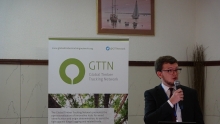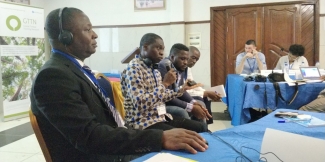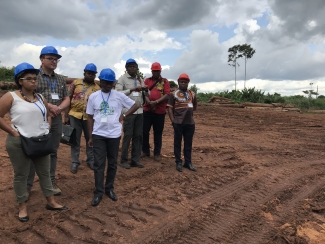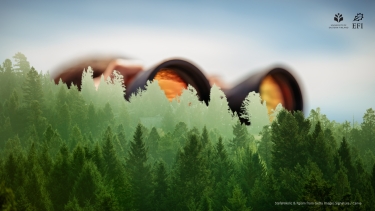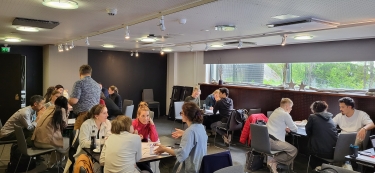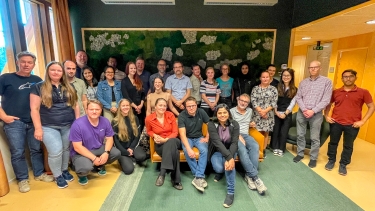Exploring GTTN Network in Africa
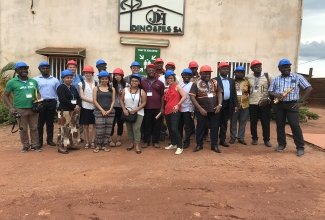
To increase awareness amongst African stakeholders from the field of research, government and non-governmental institutions, development partners, and the private sector about the Global Timber Tracking Network (GTTN), and the growing potential of timber tracking techniques to help curb illegal logging in Africa, GTTN organized its Regional Workshop Africa in Younde, Cameroon on 27-28 June 2018.
Aim of the workshop – which was planned in collaboration with Bioversity International – was not only to increase awareness of stakeholders in Africa about GTTN but also to identify interest and potential demand or prospective barriers for adoption of timber tracking techniques on the continent. In collaboration with African stakeholders, GTTN wanted to explore the needs for knowledge transfer and financial assistance for developing skills, knowledge and tools and with the aim to adopt timber tracking technologies including the collection of sample material and the development of reference data. Africa is hardly presented on GTTN's map of service providers. Since GTTN is currently finalizing a Service Providers Directory, the workshop also served to map existing capacities and know-how with laboratories already involved with timber tracking as well as with laboratories that currently apply their competencies to other areas (e.g. agriculture, CITES species other than wood etc.). Further important topics were handling and sharing of intellectual property rights (IPR) as well as issues relating to Access and Benefits Sharing (ABS). Finally, the workshop aimed at identifying interest for the development of strategic partnerships (with private sector, key institutions and decision makers) within African countries in the application of the timber tracking technologies and thereby exploring avenues for collaboration and up-scaling the GTTN initiative between demand and supply side countries for effective wood traceability systems.
Hauke Brankamp from the German Embassy in Cameroon opened the meeting by stressing the importance of an active network in the timber producing countries. His call was enthusiastically answered by the ca. 25 participants coming from across the continent, and bringing experiences from within research institutes, local authorities, policy, NGO’s, as well as private companies.
After an introduction to GTTN’s concept and activities (Jo Van Brusselen, GTTN Project Coordinator), and some insights to the role African stakeholders play within the network (Gesche Schifferdecker, GTTN Communications Manager), Marius Ekué (Bioversity representative in Cameroon and GTTN Steering Committee member) discussed local capacities and made quite clear that an investment in capacity building and technology transfer (especially to the Congo Basin countries) are needed. An adoption of timber tracking technologies requires the development of skills, knowledge and tools, but also the possibility to apply the tools directly in the producing countries.
Introducing timber identification methods
Following Marius’ engaging speech, four different methods of wood identification were presented. Harisoa Ravaomanalina (Scientific Authority of CITES Madagascar) introduced wood anatomy as an identification tool for the most commercialized Malagasy woody species. She also elaborated on the challenges of data collection, because the Dalbergia species she is working on are threatened to become extinct and samples are rare. Harisoa’s presentation was followed by an introduction to wood DNA analysis by Marius Ekué, who addressed the advantages of this method when it comes to the identification species and the geographic origin, but also stressed the importance of a collection of sample material and the development of a reference database. Micha Horacek (Francisco Josephinum Secondary College and Research Institute in Austria) shared insights of his work with stable isotopes. He explained that when a tree grows and takes up water, nutrients and carbon dioxide, these stable isotope ratios are passed on to the wood, imprinting it with a geographical marker that can be used to identify the wood’s origin. However, isotope ratio analysis cannot be used for species identification. Finally, Cady Lancaster (US Forest Service & National Fish and Wildlife Forensic Lab) shared her video contribution to discuss the advantages and limitations of DART TOF Mass Spectrometry, which analyses the chemical composition of wood for species identification. (If you want to learn more about the advantages and limitations of the different timber identification methods, check out our section on the GTTN website here).
Demands and barriers for timber tracking in Africa
The third session was dedicated to identify interests, demands and barriers for timber tracking in Africa. The first speaker, Richard Gyimah (Ghana Forestry Commission) elaborated on the potential of wood identification techniques application in Ghana. Richard stated that as a VPA country, Ghana has a timber legality assurance system (TLAS) – and even if the innovative tools are not used yet, he supported their future application and stressed the need to take the respective policy makers on board. Concentrating on the scientific capacities in West Africa, Emmanuel Opuni-Frimpong from the University of Energy and Natural Resources in Ghana shared his experiences with the development of a centre of competence for wood identification in Ghana. His presentation was followed by that of Eric Essomba (Environmental Investigation Agency) exploring the potential of wood identification techniques in EIA investigations in the Congo Basin. EIA is currently building capacity of local civil society organisation to collect Okoume’s samples in the region. Germain Yene Yene (Gersyn Services) discussed about his challenges of organizing various sampling campaigns mostly in Central Africa.
Even though all speakers work in different environments and countries, they all stressed the importance of increasing regional discussion and cooperation also with local governments to strengthen regional capacities and cooperation amongst African countries to detect and prevent illegal timber trade in the region.
Frameworks for cooperation in Africa
The final session of the day had a very practical approach aiming at the development of frameworks for cooperation in and with Africa. The session started with a presentation of Yves Nkoum Messoua from the National Support Agency for Forest Development (ANAFOR) in Cameroon. Ives shared ANAFORS’s experience with CITES, wood identification and the protection of African forests with a specific focus on the genetic traceability of Assamela (Pericopsis elata) in Cameroon. Illegal logging and habitat loss pose a realistic threat to Assamela, which is among the most valued tropical hardwood timber species. Following decades of extraction in the 20th and 21st century, the species is listed on CITES Appendix II. Since it is not only found in Cameroon but also in neighbouring countries like Republic of the Congo, DRC, Ghana and Nigeria, collaboration is crucial. Ives’ presentation was spontaneously followed by the one of David Odee (Kenya Forest Research Institute - KEFRI) who offered insights to East African cooperation initiatives and international projects on tropical tree species that KEFRI have conducted. The last presentation of the day was held by Pacyinz Lyfoung (Public Interest Intellectual Property Advisors/PIIPA). She addressed the issue of handling and sharing of intellectual property rights, concerning technology, methodology and reference data. Thereby she also introduced questions relating to Access and Benefits Sharing (with reference to the Nagoya Protocol).
The presentations were followed by a panel discussion with several speakers of the day and active engagement of the workshops’ participants. After a follow-up on Pacyinz’s speech and controversial debates between scientists and policy makers (who had different approaches to the topics), the group discussed whether African timber producers focus more on working on timber species used in the domestic, intra-African or on international markets. Interestingly, contributions suggested that all are important, depending both on wood species and producer countries. The panelists also identified key stakeholders in the region to further promote and develop the GTTN network and potential focal points. Finally, the participants decided to continue the exchanges during the World Café planned on the following day.
World Café and excursion
The morning of the second day aimed at discussing four different questions in four consecutive and rotating sessions. The table facilitated by Marius Ekué targeted at developing strategic partnerships (with the private sector, key institutions and decision makers) within African countries in the application of the timber tracking technologies. Nele Schmitz (Thünen Institute) identified what capacities for wood identification tools are currently present in Africa (direct or hidden, i.e. methods not used on wood yet) and what capacities still need to be developed. Pacyinz Lyfoung proceeded the engaging discussion of the former day and worked with her group on solutions for local protection in the framework of global cooperation with a specific focus on IPR and ABS. The fourth table was moderated by Jo Van Brusselen who further developed GTTN’s approach of timber species prioritization for reference data development.
The meeting was closed by a visit to the local sawmill Dino & Fils SA, thoroughly guided by the managers Daniel Abomo and Njidam Moussa. From logging to various processing phases, the company provides clients domestically and globally with logs and intermediate to final products. It was demonstrated that the company takes high regard of production and environmental standards. During the visit the participants of the Regional Workshop learned of Dino & Fils’ processes and chain-of custody and how they operate vis-a-vis due diligence requirements of domestic and international markets.
More information on the results of the World Café discussions and a report on the excursion to Dino & Fils from a personal perspective will be provided soon. For further information keep an eye on our news items on the GTTN website or subscribe to the GTTN newslett

